Powdery Mildew: Identification, Prevention, and Treatment
When we start gardening, we know that we should expect some disease and pests, but sometimes they catch us off guard. Powdery mildew was one of the diseases that I didn’t expect, and it always hits my garden hardest at the end of summer. In the podcast episode and blog post below, learn how an organic gardener can identify, prevent, and treat this common fungal disease when it strikes.
How to Identify Powdery Mildew
Powdery mildew is easy to spot because the leaves look like they have been sprinkled with flour. Even before that, we can see discolored areas on the leaves as the fungus begins to grow. When left unchecked, it can cause the leaves to shrivel and the fruit to mature prematurely without its full flavor and texture.
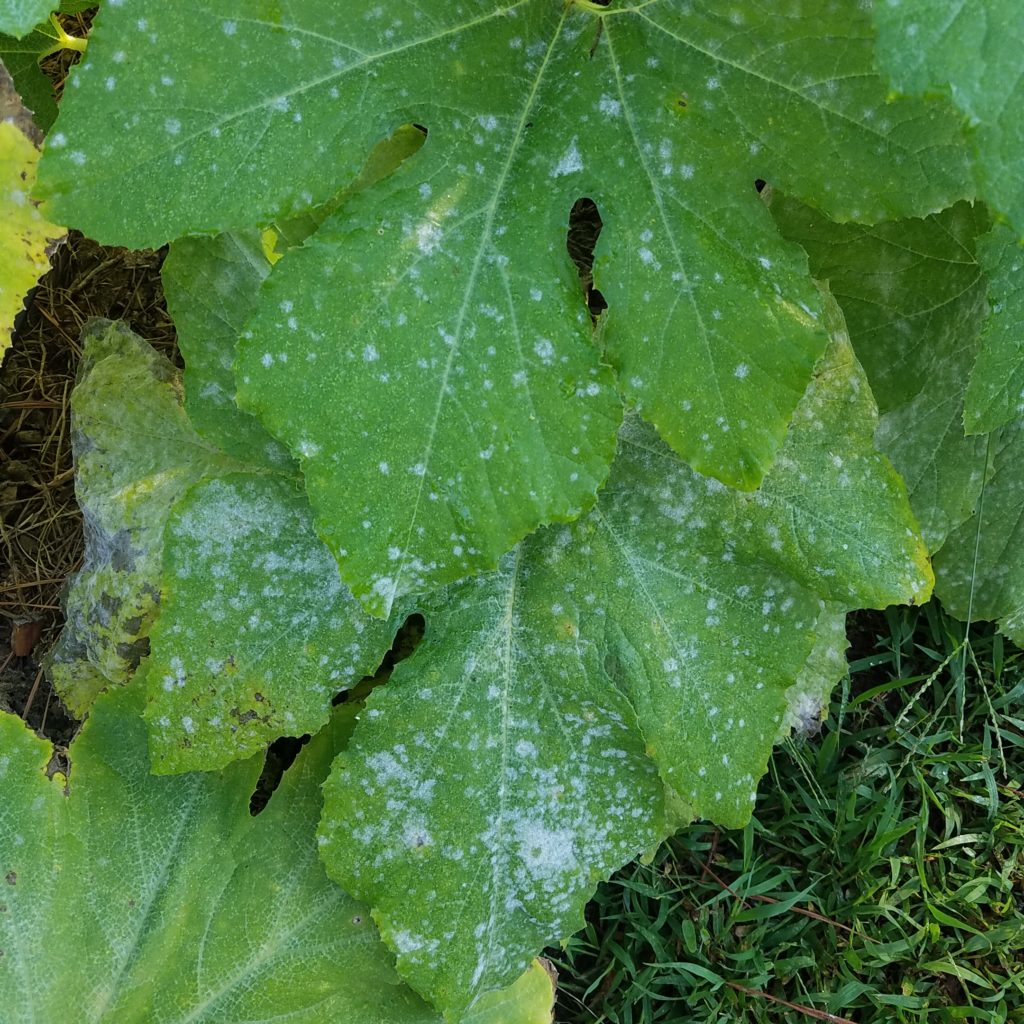
Powdery mildew can affect a wide variety of garden plants, but the most common susceptible vegetables are cucumbers, squash, zucchini and melons. It can affect flowers like roses, zinnias, lilacs, and phlox. It can even affect fruits like apples and grapes. Different species of powdery mildew grow on different plants. So what grows on your apples is not what grows on your squash.
Ideal Conditions
This type of fungus functions a little differently than others like early blight. Powdery mildew loves the hot daytime weather with cooler nights. In my southern garden, that tends to be in August and September. Powdery mildew needs high humidity for the spores to germinate. It also tends to form and spread more rapidly on plants in a damp and shaded area.
Powdery mildew also differs from other fungal diseases because it does not necessarily flourish when the weather is rainy. If the humidity is above 90%, the rate of powdery mildew decreases.
Drought-stressed plants are more likely to be affected by powdery mildew. In many areas, this is another reason this disease flourishes in the late summer; many of us experience the most dry times of the year then.
Young leaves are also more susceptible to powdery mildew than older leaves, although it may be easier to detect on mature leaves.
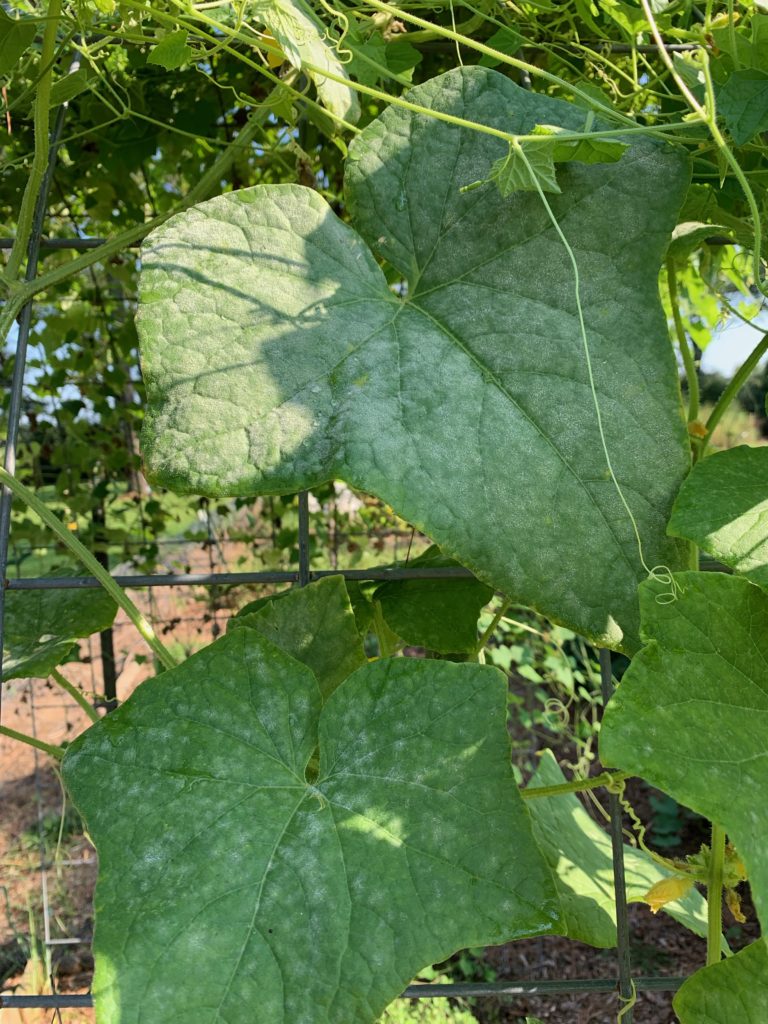
Prevention
First, look for resistant cultivars — the varieties of your crops that are more resistant to powdery mildew. Choosing the right variety will go a long way toward prevention.
A few highlights regarding powdery mildew-resistant cultivars:
- Squash: General Patton
- Winter squash: Butternut 401, Bush Delicata
- Cucumbers: Marketmore 76, Boston Pickling, Picklebush.
Besides planting resistant cultivars, another method to prevent powdery mildew is to make sure your plants are spaced properly so that there is enough air circulation. You can even prune the lower leaves to improve air circulation.

Try to stay on top of watering and make sure your crops are well mulched to prevent drought stress.
Also, avoid nitrogen fertilizer towards the end of summer. Nitrogen will cause new growth, which is more susceptible to powdery mildew.
When you notice the early stages of the fungus, remove the diseased leaves. Make sure to dispose of them and don’t compost them to prevent spread.
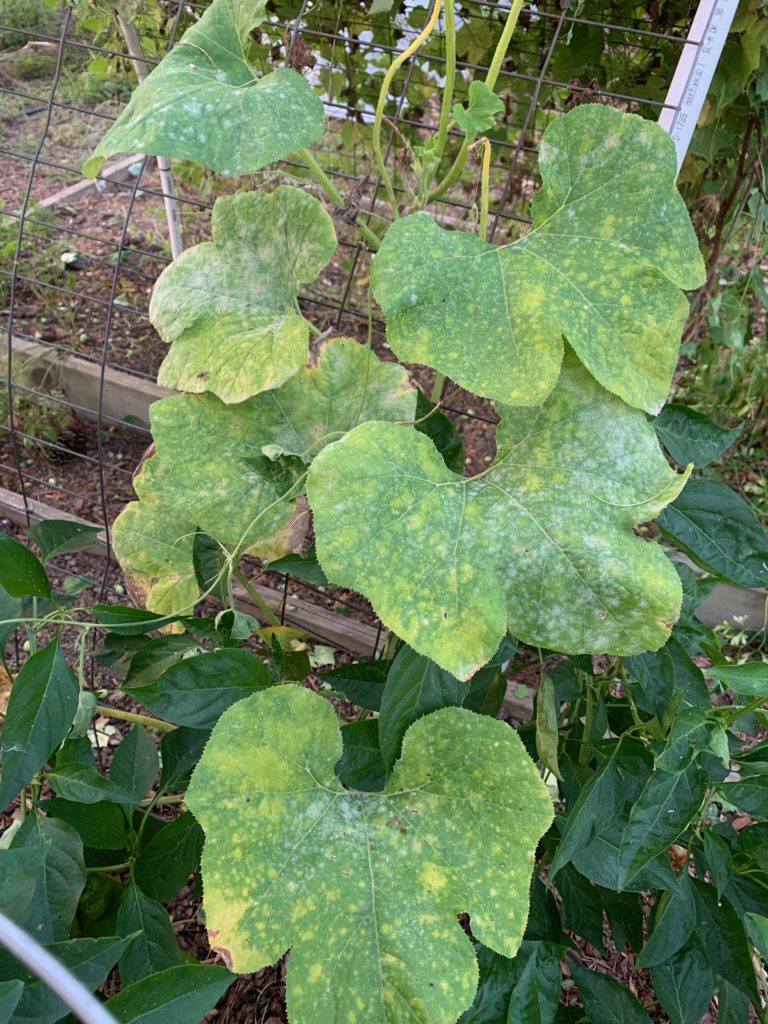
How to Treat Powdery Mildew Organically
When you first see powdery mildew, you will want to use an organic fungicide to prevent spread. Make sure that you get to this early because it is difficult to treat after the infection has gone for too long.
Horticultural oils. Horticultural oils are considered one of the safest options to prevent and treat powdery mildew infections.
Baking Soda spray – Apply primarily as a preventative, but it can help control spread. Here are three recipe options:
- 1 tsp baking soda to 1 quart of water (quickest, homemade option. This is what I used with decent results.)
- 1 tbsp baking soda, 2.5 tbsp horticultural oil, 1 gallon water (Cornell University via Colorado State)
- 1 tbsp baking soda, 1 tsp dormant oil, 1 tsp liquid soap like castile soap, 1 gallon water (Joe Lamp’l – Growing a Greener World)
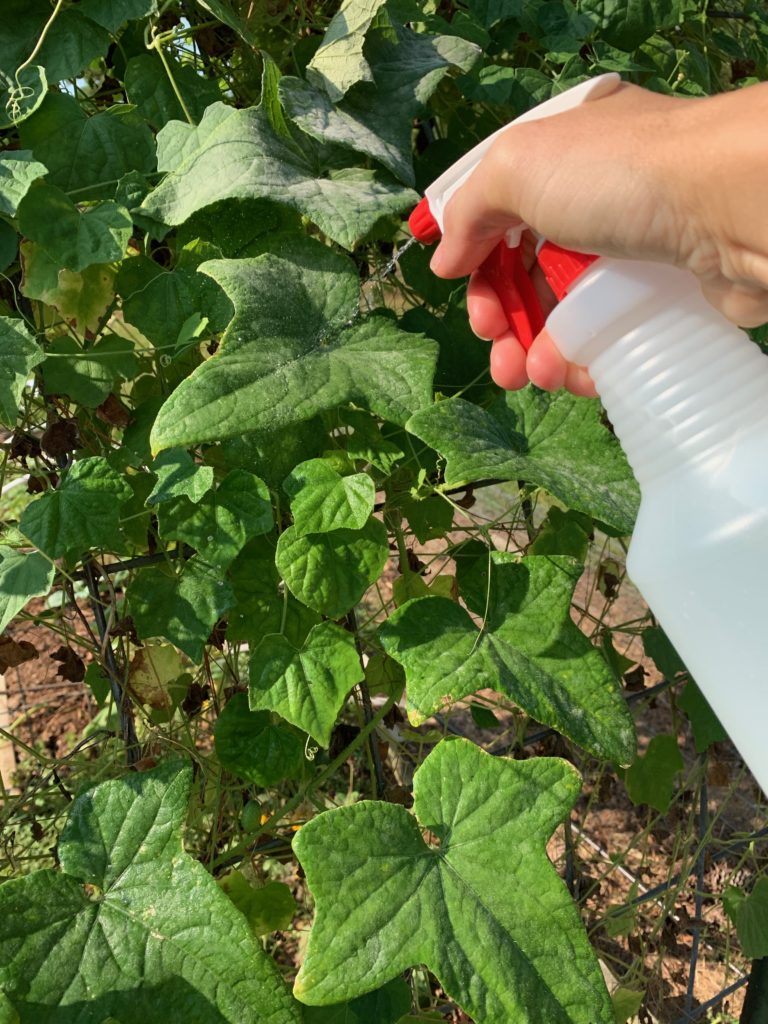
Neem oil – Considered a fairly safe insect repellent, this might be an option to both prevent powdery mildew and deter other pests. Follow mixing instructions on bottle, and I recommend not using this if your plants are already flowering, because it can harm pollinators.
Milk spray – If you don’t want to purchase a product, I recommend trying a simple diluted milk spray. I’ve seen anywhere from 10% to a 50% milk to water ratio, so you may experiment and see what works.
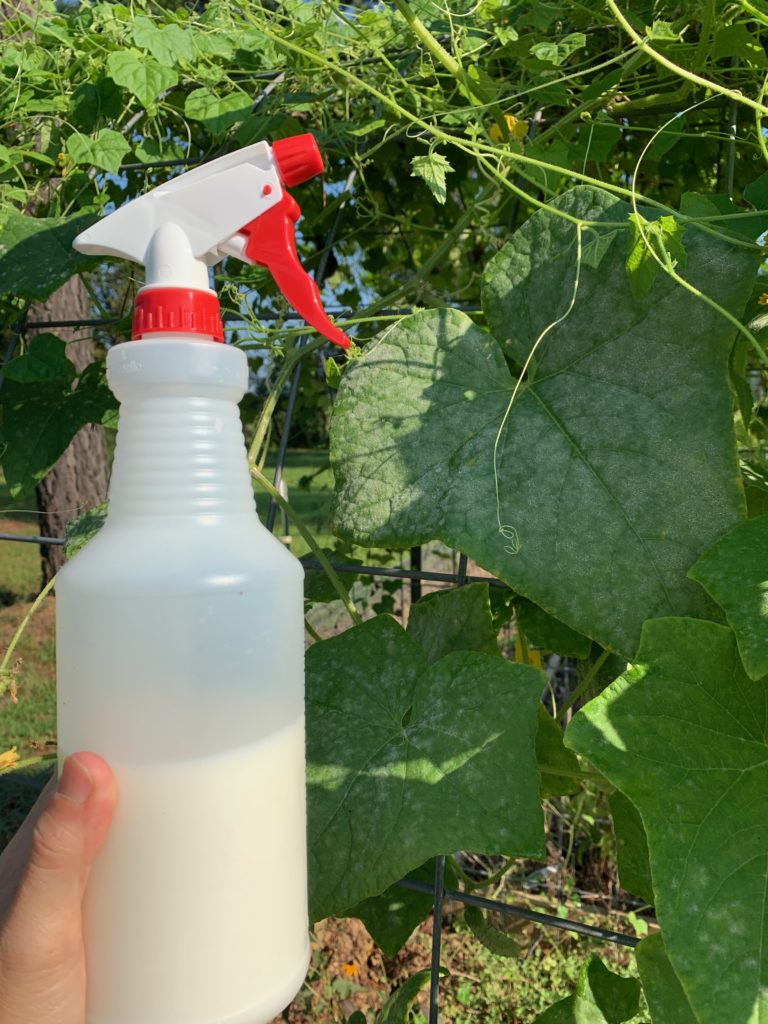
Serenade spray – With the active ingredient being bacilus subtilis, Serenade is a preferred option for many organic home gardeners. Follow mixing instructions on bottle.
Sulfur spray – While this is approved for organic gardening, sulfur spray might need to be considered as a last option. Although it is considered highly effective, be careful because it can burn your plants. Do not use when the temperature is over 90* or within 2 weeks of using any oil.
Powdery Mildew Treatment Precautions
Regardless of which method you choose, test first to ensure you don’t harm your plant. If you use a packaged product, be sure to follow the instructions on the bottle.
If you are making your own (such as a baking soda spray or milk spray), apply every 1-2 weeks and spray in the morning.
Further Organic Prevention and Treatment Options
After initially publishing this blog post and podcast episode, a podcast listener who is a licensed commercial pesticide applicator specializing in Integrated Pest Management sent me more resources he recommends to organic gardeners looking to prevent and fight powdery mildew.
- Zerotol 2.0 — uses acetic acid and hydrogen peroxide type chemicals to prevent and wash powdery mildew. Start immediately upon planting and spray weekly or even twice weekly until harvest.
- Regalia and Double Nickel — two bio-fungicides that are labeled to help control powdery mildew.
- M-pede — triple labeled insecticide/miticide/fungicide.
As mentioned above, always test to make sure any treatment doesn’t burn your plants. Of the ones above, M-pede is the most likely; the others are less likely to burn. Also, read the labels carefully on any treatment, as some may require the use of a respirator, even as an organic treatment.
Conclusion + Further Resources
When we spot powdery mildew on our vegetable, flower, or fruit plants, we want to do whatever we can to eradicate the problem. While the treatments above may help, much of your success against powdery mildew will depend on how fast you start treating it. Sometimes, you may have to make the decision to pull a plant to prevent further spread. Then next season you know what you’re up against and can take measure to plant in the right place and prevent a major infection in the future.
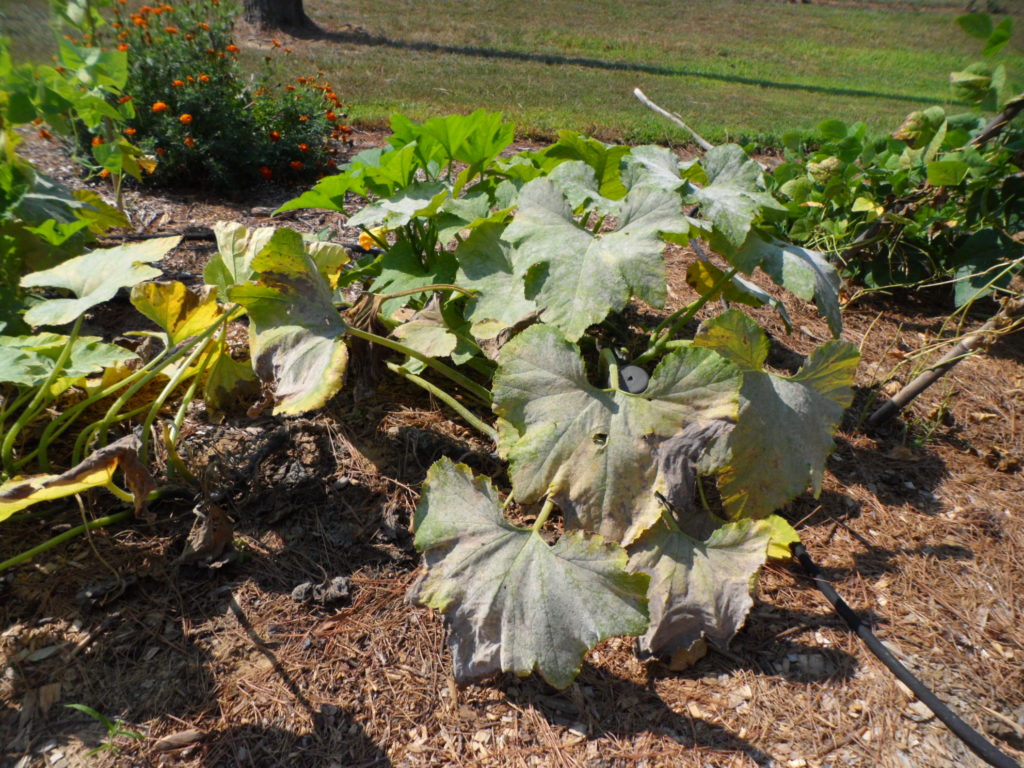
Is powdery mildew a disease that has shown up in your garden? What has been most effective for you?
Sources for this article and further reading:
- https://extension.colostate.edu/topic-areas/yard-garden/powdery-mildews-2-902/
- http://ipm.ucanr.edu/PMG/PESTNOTES/pn7406.html
- https://www.growingagreenerworld.com/controlling-or-eliminating-powdery-mildew/
Do you get overwhelmed with garden planning?

Subscribe here for my best tips to plan your garden in just 7 days -- all for FREE.
Plus, I'll send you my "In the Garden E-mail" on Fridays, periodic updates on garden resources relevant to you, and you'll receive access to my entire bank of free garden downloads!
You are also agreeing to our privacy policy.

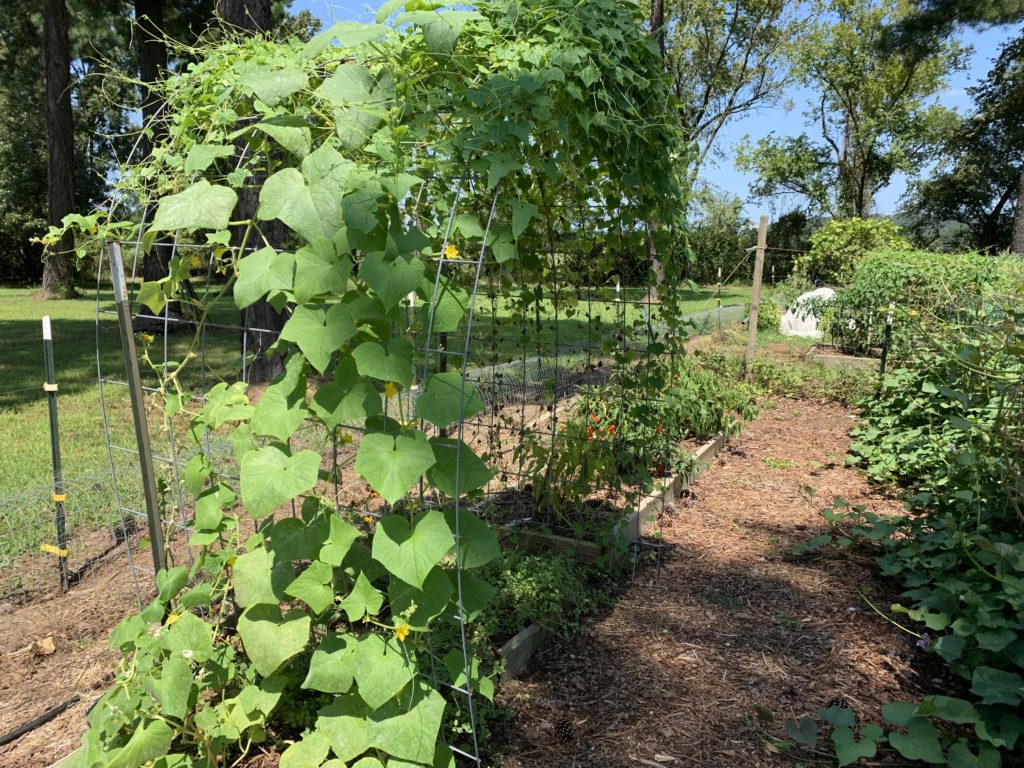
very helpful article. it helps me a lot as my vegetable trees are fallen in this problem. thanks for sharing this article
Glad you found it helpful!
The link you provided in the paragraph about using milk spray, entitled “This is the method I used”,
goes to information about baking soda. Did you mean to place that link in the paragraph about baking soda?
Yes, I’m not sure where the mix-up was on that! Here’s a milk spray from a reputable gardener: https://www.growveg.com/guides/using-milk-to-prevent-powdery-mildew/